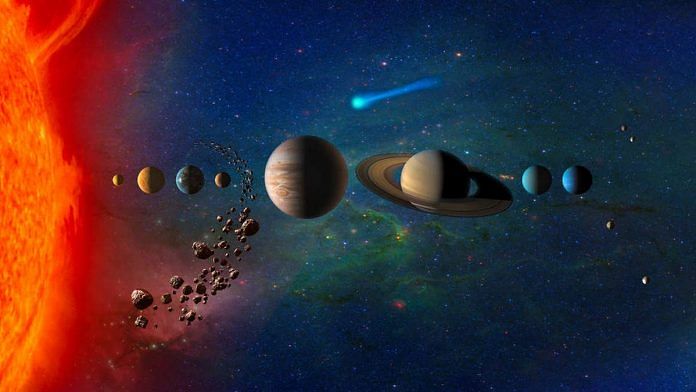New Delhi: The European Southern Observatory’s Very Large Telescope has taken the first-ever image of a young, Sun-like star accompanied by two giant exoplanets.
The new planetary system, known as TYC 8998-760-1, is located about 300 light years away. Such direct images of systems with multiple exoplanets are extremely rare and never before have astronomers directly observed more than one planet orbiting a star similar to the Sun.
The star has two gas giants orbiting at distances of 160 and about 320 times the Earth-Sun distance. This means that the planets are much further away from their star than Jupiter or Saturn are from the Sun.
The two exoplanets are also much heavier than the ones in our solar system, the inner planet having 14 times Jupiter’s mass and the outer one, six times more.
These observations can help astronomers understand how planets formed and how they evolved around our own Sun. More on Space.
Ancient humans may have migrated to Americas much earlier than thought
Researchers claim that ancient humans may have occupied a cave in the mountains of central Mexico more than 30,000 years ago. This suggests that humans arrived in North America at least 15,000 years before what was previously believed.
Archaeologists discovered hundreds of ancient stone tools at the site, which, along with data from other sites, they’re using to back their claim. But their conclusion is disputed by other scientists since although it is known that the first humans in the Americas came from East Asia, the date of their arrival is a matter of debate. The more commonly held view is that the peopling of the Americas began about 15,000 or 16,000 years ago — based on genetic evidence and artefacts found at sites.
The new study is being questioned because all researchers are not convinced that the excavated artefacts are in fact tools. Sceptics argue that these tools are so simple that they may have been formed by geological processes rather than made by humans. More on Nature.
Also read: UAE sends Hope to Mars in the Arab world’s first mission to the Red Planet
Scientists detect first underwater methane leak in Antarctica
Scientists have detected an active leak of methane gas in Antarctic waters for the first time.
Methane is a potent greenhouse gas and while underwater methane leaks are not a new phenomenon, usually certain methane-eating bacteria help keep such leakages in check by not letting much escape into the atmosphere.
However, according to a new study, these microbes took roughly five years to respond to the Antarctic leak, and were not able to completely consume the escaping gas. The leak allowed the methane to seep into the atmosphere for five years, which is something current climate models do not account for when predicting the extent of future global heating. More on the BBC.
Sharks are disappearing from the world’s coral reefs
Sharks are absent from many of the world’s coral reefs, indicating they are functionally extinct — that is, they are too rare to fulfil their normal role in the marine ecosystem.
A team of scientists surveyed 371 reefs in 58 countries. Sharks were not seen on nearly 20 per cent of these, indicating a widespread decline that has gone undocumented until now. During over 800 survey hours around the reefs in the Dominican Republic, the French West Indies, Kenya, Vietnam and Qatar, a total of only three sharks were observed.
The loss of reef sharks around the world is alarming since the species is an important part of food resources and diving tourism, and are among the top predators on coral reefs. Overfishing of sharks and destructive fishing practices are blamed for the loss of this iconic species. More on The Guardian.
Scientists study why some mosquitoes have a taste for humans
Certain mosquitoes seem to have developed a preference for human blood, especially in places with intense dry seasons, a new study of African mosquito species suggests.
Researchers propose that since mosquitoes need water to breed, and humans tend to store water in large quantities, especially in dry areas, some mosquitoes have ‘specialised’ in biting humans.
Aedes aegypti mosquitoes, which spread diseases like Zika, dengue and yellow fever, often specialise in humans, bringing diseases with them. However, most African mosquito populations of the species have a wider diet. To understand what makes some mosquitoes prefer humans, researchers captured A. aegypti eggs from 27 sites in sub-Saharan Africa and raised them in a lab.
The mosquitoes were then put in a chamber where they could catch a whiff of either a human or an animal to see which they would move towards to attempt to bite. But no pattern of preferred diet emerged.
Further research showed that in areas where the dry season was long and intense, mosquitoes were much more likely to prefer humans. More on the New York Times.
Also read: How do bats stay safe from the thousands of viruses they host? New study holds some clues



